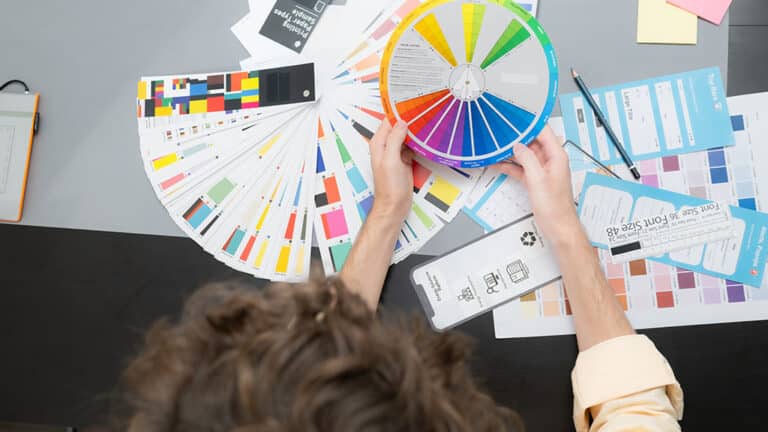How Graphic Design Shapes First Impressions of Your Business
Whether it’s a potential customer landing on your website for the first time or someone scrolling past your Instagram ad, the decision to engage—or move on—is made in seconds. Studies show that people form a first impression within just 50 milliseconds of seeing something new. That means before they read a word of your copy, look at your pricing, or hear your pitch, they’re already making assumptions based on your visual presentation.
Design is more than decoration—it’s communication. The colors you choose, the fonts you use, the spacing between elements, and the overall aesthetic of your brand send a powerful message to your audience about who you are and what they can expect from you. In many ways, your design is speaking on your behalf long before you do.
That’s why investing in strong, strategic graphic design isn’t just a cosmetic decision—it’s a foundational business move. The way you present your brand visually can set the tone for everything that follows. It can build trust, spark curiosity, or—if done poorly—drive people away before they’ve even given you a chance.
Visual Identity as a Reflection of Your Brand
Your visual identity is the face of your business. It’s the logo on your storefront, the header on your website, the graphics in your emails, and the look of your social media feed. All of these design elements work together to give people a sense of what your business is about—and whether they feel connected to it.
The first time someone encounters your brand, they’re subconsciously asking: Is this company professional? Do they feel trustworthy? Are they creative, serious, fun, or high-end? Those impressions are based almost entirely on the visual signals you’re sending.
A sleek, modern logo and clean website layout can signal innovation and professionalism. A warm color palette and handwritten typography might convey approachability and friendliness. These are not random choices—they’re intentional design decisions that align with the core of your brand identity.
This is where many businesses run into trouble. Without a clear visual identity, designs start to feel scattered or generic. And when that happens, it’s harder for people to remember your brand—or take it seriously. On the flip side, when your design reflects your values, voice, and positioning, your brand starts to become more than just recognizable—it becomes trusted.
The Psychology Behind Design Choices
Good design isn’t just about what looks nice—it’s about how visuals make people feel. The psychology of design plays a major role in how customers respond to your business at first glance. Elements like color, shape, spacing, and contrast all work together to trigger emotional and behavioral reactions, often on a subconscious level.
For example, blue is often associated with trust and professionalism, which is why it’s frequently used in industries like finance and tech. Green can suggest health, nature, or sustainability, while red creates urgency and energy. Font choices carry weight, too—serif fonts feel classic and reliable, while sans-serif fonts tend to appear modern and clean.
Even the way elements are arranged on a page impacts user experience. A cluttered design may feel overwhelming or untrustworthy, while a layout with clear hierarchy and generous spacing feels calm and organized. These micro-decisions matter, especially when they’re experienced in that first, crucial moment of contact.
The most successful brands understand this and use design intentionally to guide perception. Whether it’s through calming tones, dynamic visuals, or minimalist layouts, they’re actively shaping how people interpret and emotionally connect with their business. This is the value of working with professionals who specialize in graphic design services—they combine creativity with strategy to create designs that are not only beautiful but psychologically effective.
Website Design Sets the Tone
Your website is often your business’s first real handshake with a potential customer. It’s where curious browsers become informed prospects—or bounce away within seconds. That’s why your website’s design matters so much. Before anyone reads a blog post, checks your pricing, or contacts your team, they’re assessing your business based on how your website looks and functions.
A well-designed website immediately communicates credibility. Clean layouts, professional imagery, intuitive navigation, and consistent branding all create a smooth and engaging experience. If your site feels polished, visitors are more likely to trust that your business is equally professional. But if your website is cluttered, confusing, or outdated, visitors may assume the same about your services or products.
Speed and responsiveness also play a role in first impressions. Today’s users expect a fast, mobile-friendly experience. Even if your content is excellent, a slow-loading or poorly optimized website can turn people off before they ever see it. Visuals should load quickly, and layouts should adapt seamlessly across devices.
Design choices like button placement, whitespace, and font readability all influence how easy it is for someone to move through your site. When users can find what they’re looking for without friction, it sends a strong signal that your brand values their time—and that builds trust right from the start.
Social Media Graphics Build (or Break) Trust
In the social media age, your business is often judged in the blink of an eye—while someone is scrolling through their feed. Social platforms are highly visual spaces, and the quality of your design can make the difference between being noticed and being ignored. If your graphics look generic, low-resolution, or inconsistent, users may keep scrolling without a second thought.
But when your social posts are professionally designed and clearly aligned with your brand’s tone and style, people stop. They notice. And more importantly, they start to form a perception of your brand as credible and relevant. That first impression, even if it’s just from a post or ad, can be enough to inspire someone to click, follow, or explore further.
Consistency is key here. If your posts bounce between different styles, colors, or messages, it creates confusion. But when your feed has a cohesive look and feel—when each post clearly belongs to the same brand—you build familiarity. People begin to recognize your brand instantly, even before they read the caption.
This visual consistency also reinforces trust. It signals that you’re intentional, detail-oriented, and committed to a certain standard. And in the fast-paced world of social media, that trust can turn passive followers into loyal fans—and eventually, into customers.
Packaging and Print Materials Matter Too
While digital design gets most of the attention these days, your offline materials are just as important—especially for businesses with physical products, in-person events, or print-based marketing strategies. Your packaging, business cards, brochures, signage, and other printed materials are all opportunities to make a powerful first impression.
For product-based businesses, packaging design can be a make-or-break moment. Shoppers often make split-second decisions based on how a product looks on the shelf. If the packaging feels premium, thoughtful, and well-branded, it can elevate the perceived value of what’s inside. But if it feels generic or poorly designed, it can undermine even the best product.
Print collateral like brochures or mailers also tell a visual story. A well-designed piece not only conveys information—it reflects the care, quality, and identity of your brand. In a world where print has become more intentional, beautifully designed materials stand out and leave a lasting impression.
Even something as small as a business card carries weight. A card that’s visually appealing and well-crafted can signal professionalism and leave a positive mental imprint after a meeting or networking event.
First impressions don’t just happen online. Every visual touchpoint—whether it’s a package, a flyer, or a storefront sign—contributes to the way your audience perceives your business. When design is consistent and high-quality across all formats, that perception becomes stronger and more trustworthy.
Typography and Readability Impact User Perception
When it comes to first impressions, typography might seem like a minor detail—but it plays a much bigger role than most people realize. The fonts you use, how they’re sized, spaced, and styled, all contribute to the tone and readability of your brand. Poor typography can make content hard to read or visually unappealing, which can lead to a negative perception of your business.
Typography sets the mood. A classic serif font might convey tradition and trust, while a modern sans-serif font can signal innovation and clarity. Script fonts can feel elegant and personal—but when overused or applied in the wrong context, they can quickly look unprofessional or difficult to read. The key is using typography that complements your brand personality and enhances the overall design.
Readability is equally important. If your text is too small, too dense, or set in a hard-to-read font, users will likely bounce before absorbing any of your message. First impressions aren’t just about the aesthetics—they’re about ease of use. Can your audience quickly scan headlines? Can they find key information without squinting or zooming in?
Professional designers understand how to use type strategically to guide attention, support messaging, and improve the user experience. Well-executed typography builds visual hierarchy, reinforces brand tone, and makes your content feel approachable and trustworthy from the very first glance.
Poor Design Creates Doubt and Confusion
Just as great design builds trust, poor design instantly does the opposite. Inconsistent, outdated, or amateur visuals signal to your audience that your business may not be polished or credible. Unfortunately, even if your products or services are top-tier, bad design can create enough doubt to stop a potential customer in their tracks.
When a brand’s visuals look cluttered, disjointed, or off-brand, people start to question the quality of what’s behind it. Is this business legitimate? Do they pay attention to detail? Will they deliver a professional experience? These are all questions that arise from subconscious cues picked up during that critical first impression.
Unclear or mismatched visuals also create confusion. If your website looks nothing like your social media or your printed materials feel disconnected from your brand voice, it becomes difficult for people to form a solid understanding of who you are. That confusion erodes confidence—and without confidence, it’s unlikely someone will move forward with a purchase or inquiry.
Avoiding these pitfalls means being intentional with every design decision. Your audience is constantly evaluating, and design mistakes—no matter how small—can add up quickly. Making sure your visual presence feels unified, refined, and reflective of your brand’s value is essential to shaping the right perception from the very start.
Consistency Reinforces Recognition and Reliability
One of the most powerful things design can do for your business is build consistency. A consistent visual presence across platforms makes your brand easier to recognize, easier to remember, and more trustworthy. When someone sees your logo, color palette, and design style in multiple places—your website, social media, packaging, and even customer service communications—they begin to feel a sense of familiarity.
That familiarity creates comfort. People like doing business with brands they recognize and understand. And when your design is consistent, it sends the message that you are organized, thoughtful, and reliable. It shows that you know who you are and how to communicate that clearly.
Consistency also makes your brand more memorable. Repetition helps embed your brand into the minds of your audience. The more they see your consistent visual elements, the more quickly they associate those visuals with your name, message, and offering. Over time, this recognition becomes brand equity—an invaluable asset for long-term growth.
To achieve consistency, your design system needs to be built around core brand elements: your logo, color palette, typography, image style, and layout structure. Once defined, these elements can be reused and adapted across all platforms. This not only strengthens your first impression—it makes all your future impressions just as strong.
Conclusion: Design Is Your Silent Salesperson
At every stage of your customer’s journey, your design is working in the background—creating impressions, building trust, and guiding decisions. In many cases, it’s your design that does the talking before a customer ever speaks to you, reads your content, or experiences your product. That’s why it’s often called your “silent salesperson.”
Strong design doesn’t just make things look nice—it builds the foundation for meaningful, lasting connections. It helps your audience feel something about your brand from the very beginning, and that emotional connection plays a powerful role in whether they take the next step.
In today’s competitive landscape, where attention spans are short and options are endless, you can’t afford to leave design to chance. Every color, font, layout, and visual element is telling a story. Make sure it’s the right one.
If you want your business to make a confident, lasting impression, your design needs to be intentional, strategic, and consistent. It’s one of the smartest investments you can make—and the impact starts from the very first look.

















